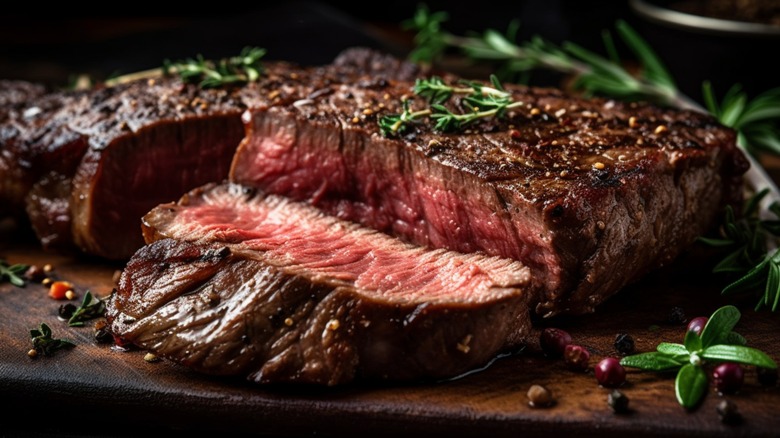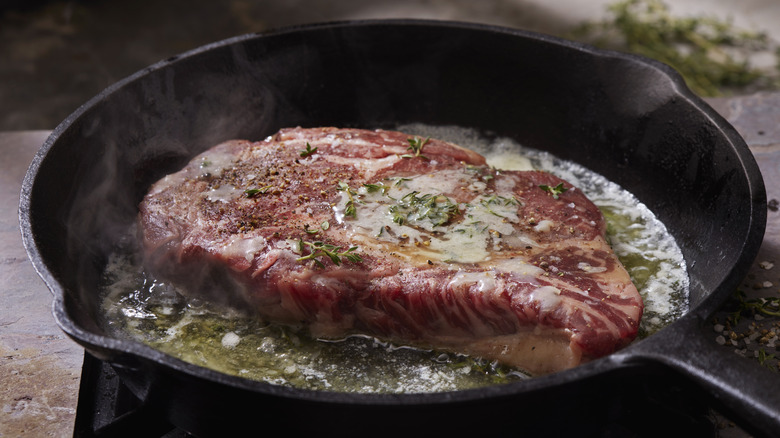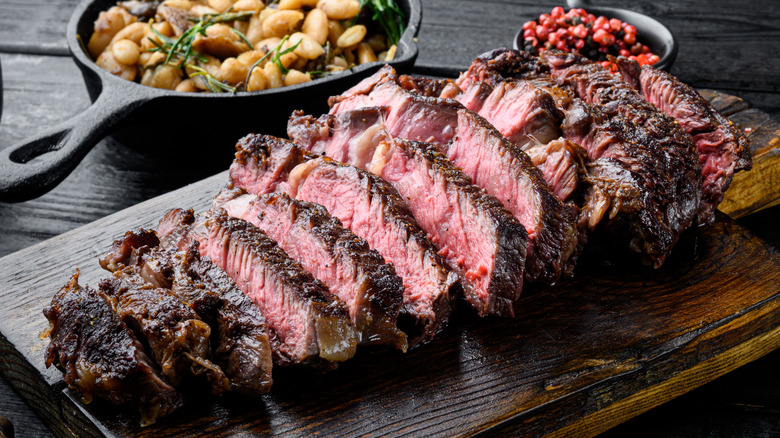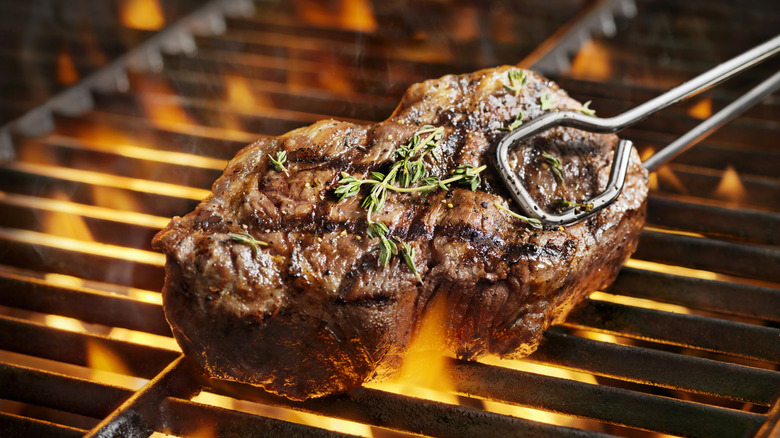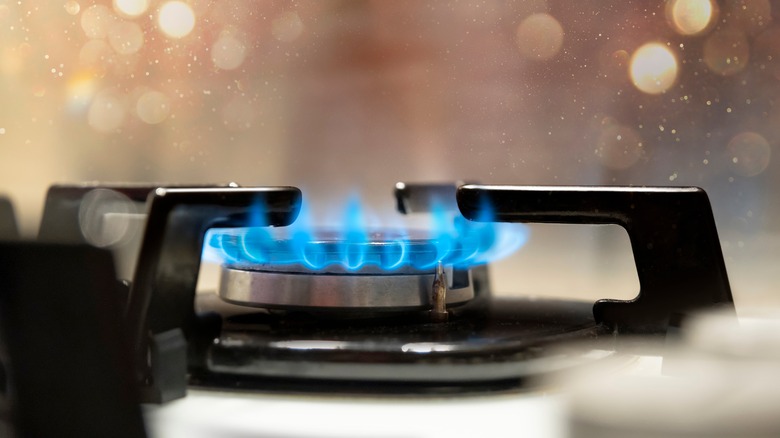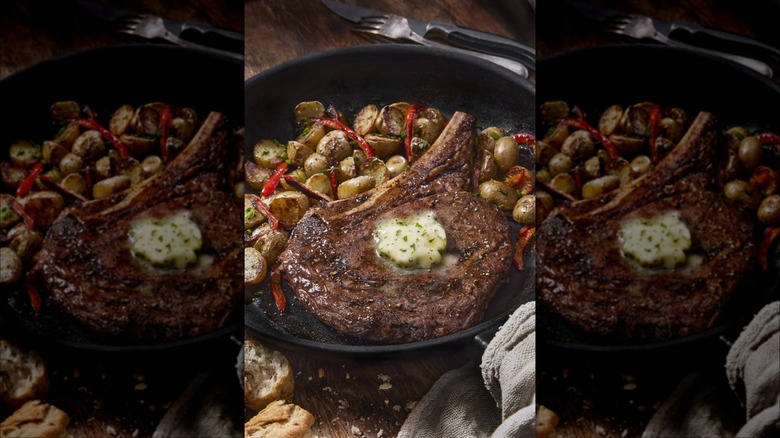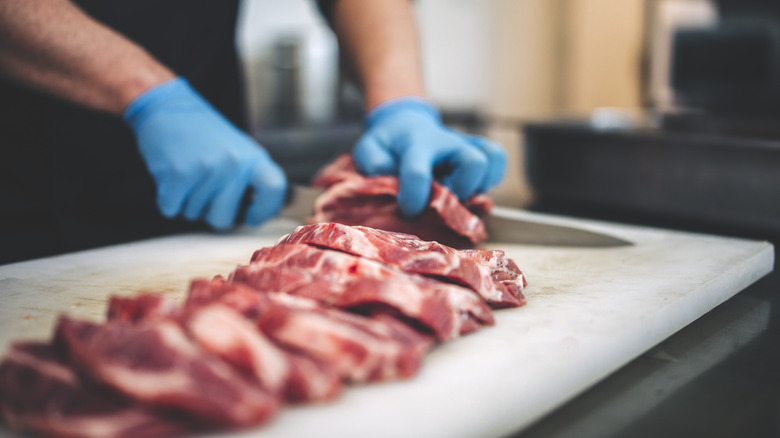How Restaurant Steak Tricks Your Tastebuds
Because it is so commonplace in many people's lives, it can be easy to forget what a luxury going out to eat at a restaurant actually is. One way to quickly remind yourself about the opulence of the experience is by ordering a thick, juicy steak. With the tantalizing aroma, the decadent flavor, and the satisfying chew that's been tailored to your preferred level of doneness, one might assume that some steaks are achieved only by magic. But the steaks they serve at restaurants are no different from the ones you might make yourself at home — the chefs just have a few tricks up their sleeves to enhance the taste.
Good steaks start with good meat, but it doesn't take an exclusive cut of beef to make a restaurant-quality steak. In fact, most steakhouses don't even use USDA Prime beef, which is a thoroughly marbled, tender, highly sought-after beef classification. Instead, many restaurants opt for the category below Prime, USDA Choice. This type of meat is more affordable, and with a few simple techniques and common ingredients, it becomes absolutely mouthwatering.
The key is salt and butter
While it certainly doesn't hurt to start your steak with a quality cut of meat, the only way to take it to the professional level is with plenty of butter. Many people avoid cooking with large amounts of butter in their day-to-day lives for fear of its high-fat content. But as the late great chef Anthony Bourdain explains in his article for the New Yorker, "Don't Eat Before Reading This," there's no avoiding this ingredient if you want to make restaurant-level dishes. "In almost every restaurant worth patronizing," he wrote, "Meat and fish are seared with a mixture of butter and oil." Cooking steaks in a bath of butter, along with a bit of garlic, rosemary, and thyme, is what makes restaurant steaks so succulent.
Another important ingredient in creating a restaurant-worthy steak is salt. Seasoning thoroughly is a crucial step when cooking any meat, and a good coating of salt is perfect for enhancing steak's savory, rich flavors. To properly salt your steak at home, most chefs recommend applying a generous coating of salt to the meat 45 minutes before you start cooking. This way, the dry salt has time to start drawing the juices out of the steak.
Restaurant quality steaks have a nice sear
Salt is also essential because it helps facilitate the Maillard reaction, which is the chemical reaction that gives steak a nice brown crust. The Maillard reaction requires high heat and moisture in order to caramelize the proteins and sugars of a given food. Salting your steak in advance allows the salt to pull out the steak's juices, which then mix with the salt to form a brine. Tossing a well-salted steak into a very hot pan induces the Maillard reaction, and can create the perfect sear. Because the Maillard reaction requires such high temperatures (over 300 degrees Fahrenheit), it is best to use a heavy cast iron pan that can handle the heat. That's another reason restaurant steaks taste so good — the kitchens are stocked with equipment intended to deal with extreme heat.
Restaurants may employ a few tricks to make their steaks otherworldly, but they also employ talented chefs who have been salting, buttering, and searing steaks for years. Replicating a steakhouse steak in your own kitchen isn't impossible, but it will take the right equipment, practice, patience, and a lot of butter and salt.
Restaurant cooks turn steaks with tongs
It might go without saying, but juicy steak requires plenty of juices, and if you turn your steak over by stabbing it with a fork or knife when you're cooking one at home, you free the steak's juices from their enslavement inside the steak and send them where they can live free again in the bottom of your skillet. Needless to say, restaurant cooks do not use a fork or a knife to flip a steak. They use tongs. That's why those juices escape to freedom, not to the bottom of the pan, but in your mouth, delivering the juicy goodness you expect from a trip to your favorite steakhouse.
So, what's the trick for flipping your steak the restaurant way? Most steak aficionados recommend just one flip. That is, you allow the steak to cook for a few on one side. Then, flip it once to cook on the other side (using tongs, of course). The rationale behind this is that if you cook it for long enough on each side, the steak will eventually be cooked evenly throughout. However, experienced cooks have learned that if all of the other conditions around cooking a steak are correct — that is, you start with a dry steak and a very hot pan — it's okay to flip the steak more than once if you feel it needs it. But always use tongs.
The steak rests for a minute
Famous chef and world-class restauranteur Anthony Bourdain insisted that a steak needs to just hang out for a few before being served. No slicing into it. No poking. No prodding. Just hanging out, chilling out. This advice might seem counterintuitive because from the outside looking in it seems like you, the home chef, and the steak lying on a plate are both doing nothing.
However, nothing could be further from the truth. A lot goes on under the surface while the steak just hangs out. What you can't see when the steak is cooling its heels is that it's still cooking for a bit inside. That red, glowing, almost raw center goes from red to pleasantly pink. The juices you love so much disperse themselves throughout the steak, ensuring that, once you finally do cut into the steak, you'll taste savory juices in every bite.
If you're trying to replicate Chef Bourdain's techniques at home, here's a good rule of thumb. Let the steak sit for five to 10 minutes on the cutting board before being served. Once the timer goes off, serve as usual.
The meat gets the high-heat treatment
The Maillard reaction is the magic that puts the savory brown coating on your steak, and restaurant cooks just seem to have this bit of chemistry mastered. And it is truly chemistry at work here. To get the crispy brown exterior on a steak, it has to be cooked at 248 F or above. Once this magical temperature number is reached, a chain reaction sets off, reducing the sugars and the amino acids inside the steak, creating a brown crust of sorts on the outside. This chain reaction creates flavors and scents that didn't exist before the chemistry experiment got started. It's not something that an uncooked steak produces on its own.
But it's not just steak that benefits from the Maillard reaction, which was named after French chemist Louis-Camille Maillard. If you've ever taken a healthy bite of the hot crust of freshly baked bread or a chewy and crunchy chocolate chip cookie, enjoyed an exceptionally fine roast of coffee, or dug into a plate of your favorite onion rings, then you've experienced this reaction first-hand. It's even one reason why your roasted veggies taste so good. The foods that best produce this reaction include dairy, eggs, seeds, and nuts. It's also worth saying that the Maillard reaction tastes different in chicken compared to steak compared to chocolate chip cookies. This has to do with the unique blend of sugars and proteins in each food.
Moisture is kept at a minimum
A few elements are required, like salt and butter, to set off the Maillard reaction. A deficit of moisture also happens to be among the elements required to start this chemical reaction. Too much moisture in the steak causes steam to arise from within, curbing the reaction. Restaurant chefs deal with this in a simple way: They pat the extra moisture off the meat before applying the seasonings.
To replicate this at home, gather four or five paper towels and lay a couple of them down on your cutting surface. Arrange the raw steaks on the paper towels, then cover them with the remaining towels. Gently press down on the steaks to "squeeze" out the moisture. With the paper towels covering your hands, pat the side of the meat dry as well. Once you're ready to season the steak, ensure that no excess moisture remains. If it does, dab it off and then season as you normally would, and you'll be cooking steak like a steakhouse chef.
It's cooked with the bone in mind
Who knew that bones could be insulation? But from a steak perspective, things are different. That is, the ribeye or T-bone that you love so much comes with some built-in insulation: the bone. Because of the bone in the middle, the cooking time on your steak can be extended, something that your average chef understands. The meat surrounding the bone cooks at a slower pace than the meat on the outer edges.
To accommodate this difference, your favorite steak restaurant cooks the bone-in steak on the grill. This allows for more even cooking while still leaving behind the fat next to the bone, one of the most flavorful parts of the steak. Some people erroneously believe that the bone itself creates a steak with more flavor than its boneless counterpart, but this is not the case. The flavor that people associate with the bone, like you'd find in a bone broth, comes from the connective tissues and the bones being cracked open to release the flavor. This doesn't happen with bone-in steak. The bones remain uncracked, contributing little to the steak's flavor.
You'll want to remember this before pan-searing T-bone steak at home. Oven cooking also works, particularly if you combine a good searing from the grill with a "finishing touch" in the oven. The result is a steak that has a crisp and savory outer coating that encases the steak's tender and juicy interior.
Chefs start with room-temperature steak
If you've ever had an issue with your steak cooking unevenly, the culprit might have been the temperature. Steak removed from the fridge and placed directly in the line of fire, so to speak, is harder to warm up than the steak that sits at room temperature for up to an hour before cooking starts. This counts as one instance where the wait was worth it. Once you get the good burn going on the steak, the results come closer to the steak you get at a steakhouse – juicy and evenly done all the way through.
For those who feel some concern about leaving raw meat out for that long before cooking, this should make you feel more at ease. Trichinosis, a raw meat-related foodborne illness brought on by a microscopic parasite called Trichinella, is extremely rare in these instances. In the cases where this does happen, the parasite comes most often from pork or wild game.
On a different but related note, the only exception that some restaurant chefs make to the don't-cook-straight-out-of-the-fridge rule is if they've dry-brined the meat ahead of time. Dry brining makes meat cook more quickly, taking away one of the issues caused by cooking cold steak. However, if all of this talk of brining takes you out of Cooking Steak 101 and into the realm of the complicated, it's perfectly okay to just start with room-temperature steak and see how much better the meat cooks.
